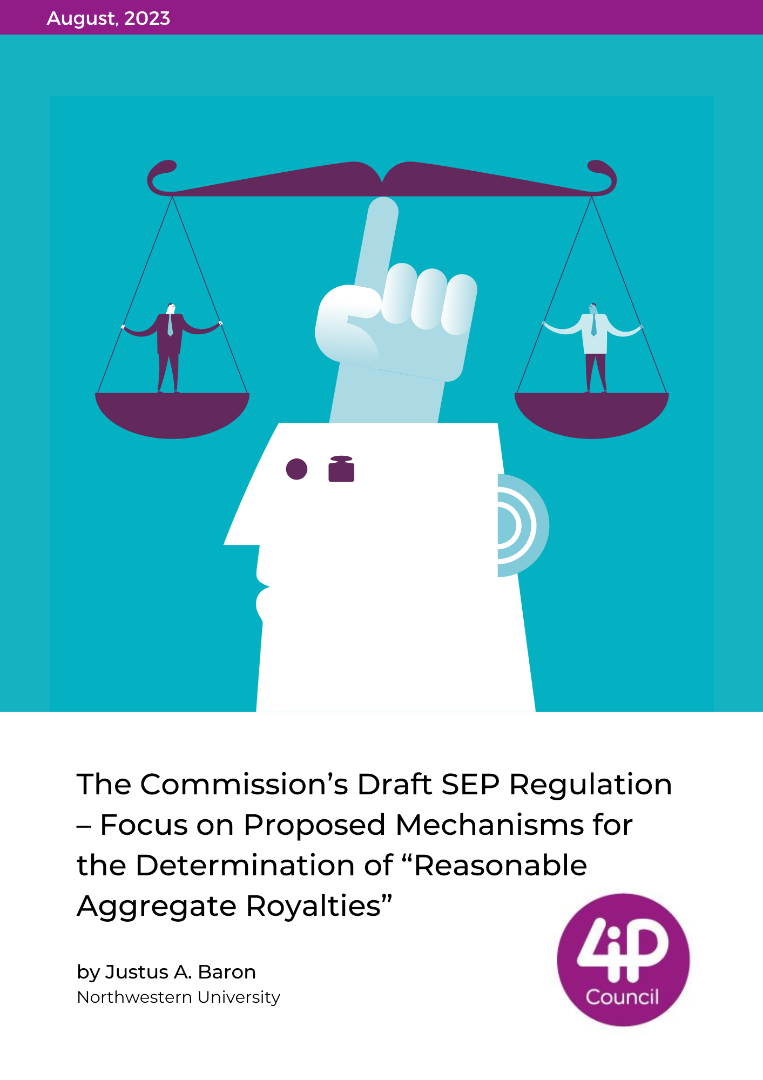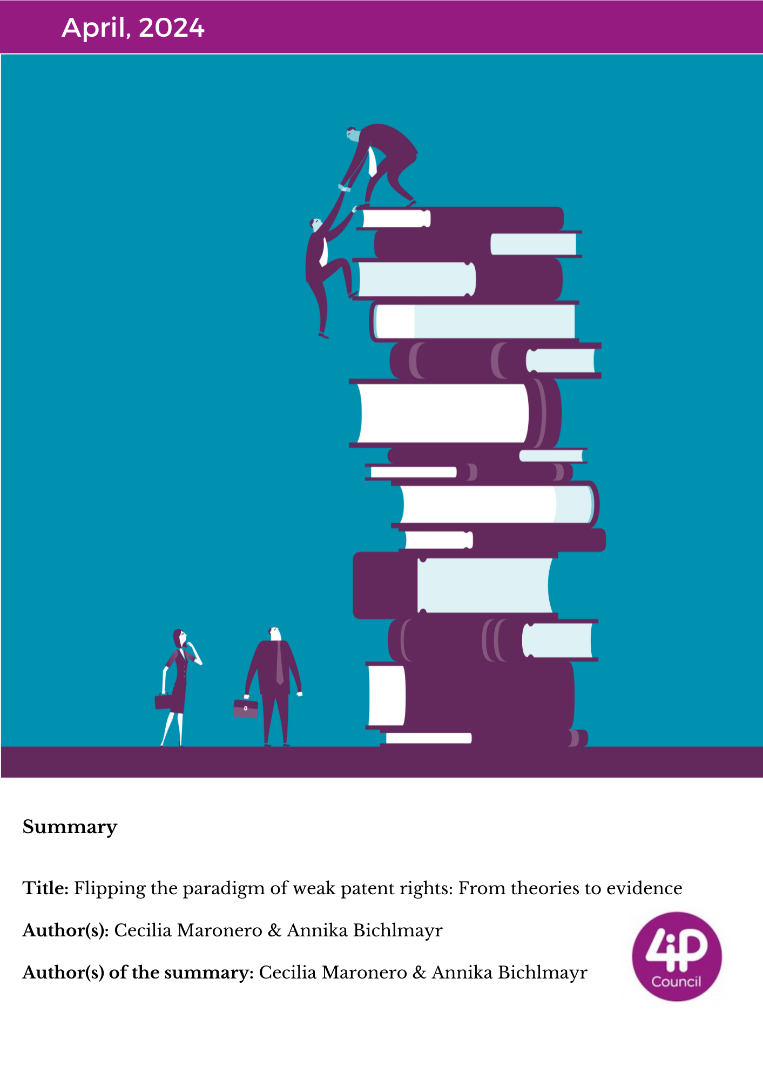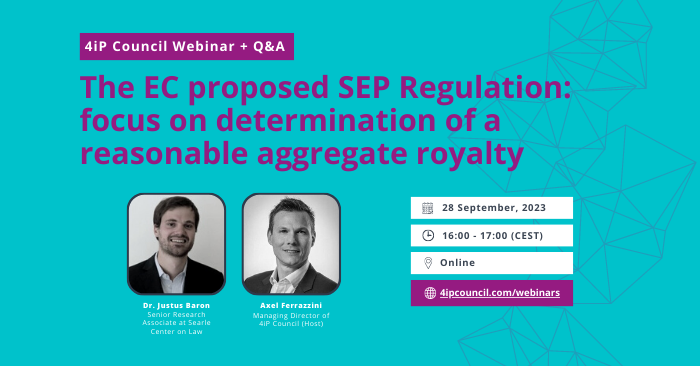Executive Summary:
The Commission’s Draft SEP Regulation – Focus on Proposed Mechanisms for the Determination of “Reasonable Aggregate Royalties”
Justus A. Baron[1], Northwestern University
On 27 April 2023, the European Commission published its “Proposal for a regulation of the European Parliament and of the Council on standard essential patents [SEPs] and amending Regulation (EU) 2017/1001” [‘Draft Regulation’]. The Draft Regulation, if adopted, will make sweeping changes to the SEP licensing framework. In particular, the Draft Regulation includes a proposal that SEP holders should agree on a ‘reasonable aggregate royalty’ for a standard. The proposal also foresees a potential intervention of a conciliator and/or a panel of experts in the determination of this aggregate royalty. In this paper, I argue that this proposal should be withdrawn or deleted from the Draft Regulation.
The idea that SEP holders should negotiate and announce reasonable aggregate royalties is not new. ‘Fair, reasonable, and non-discriminatory’ [FRAND] terms for SEP licences are often determined through bilateral negotiations between individual SEP licensors and implementers. An influential economic theory predicts that in the absence of coordination among SEP holders, the determination of royalty rates for individual SEP licences will lead to an excessive aggregate royalty burden for implementers. The prospect of such an excessive royalty burden may dissuade potential standard implementers, thus reducing the success of the standard and the profits of SEP owners and implementers alike. In this context, academic scholars and industry experts have suggested that SEP holders should agree on reasonable aggregate royalties to provide reassurance to potential implementers.
Nevertheless, the empirical evidence does not support the royalty stacking theory. The observable aggregate royalty yield in SEP-intensive industries has been shown not to exceed 5%. It is therefore unsurprising that there is no evidence that concerns about potential royalty burdens are hampering the success of technology standards. Against this background, the industry’s experience with announced aggregate royalty rates has been sobering. Existing announcements, which were made 15 to 20 years ago for past generations of technology standards, have had little tangible effects on the formation of FRAND royalty rates. More recently, there has been little interest among SEP holders to make negotiated announcements of reasonable aggregate royalties.
In my assessment, the proposed mechanisms for the determination of aggregate royalty rates are thus a solution to a problem that does not exist. The proposed mechanisms are also unlikely to elicit meaningful notifications from SEP holders. The proposal provides no new incentives to SEP licensors to make meaningful announcements of a maximum aggregate rate. The mechanism is more likely to be used by groups of net licensees, i.e. companies with an interest in bringing royalty rates down as much as possible. Announcements of low maximum rates exclusively supported by licensees are unlikely to be helpful in licensing negotiations. Instead, concertation among net licensees on a maximum rate may make it more difficult for SEP licensors to find market acceptance for their SEP licensing offers, and may ultimately convince more SEP licensors to resolve their licensing disputes in non-EU venues.
Even if the proposed mechanisms were to result in meaningful and respected statements about a reasonable aggregate royalty, the effects on SEP licensing costs would probably be limited. Consideration of the aggregate royalty currently plays only a very limited role in SEP licensing negotiations. Comparable licences are the predominant method for determining FRAND royalty rates, and there would be a continued need to assess comparable licences (if only to assess the non-discriminatory character of the offer). Also, top-down analyses would continue to be complex and costly, as parties may still have different views on the correct aggregate royalty level, and the problem of apportionment remains unresolved.
More importantly, the proposed mechanisms are not guaranteed to result in more appropriate royalty rates for SEP licences, i.e. royalty rates that sufficiently compensate SEP holders without over-burdening implementers. While the proposal calls for a determination of the aggregate royalty before the relevant product market has formed, an informed estimate of a reasonable aggregate royalty would require data on the success of the standardised technology in that market. Furthermore, aggregate royalty rates are meaningless in the absence of a formula for how the aggregate royalty rate should be shared between licensors. Distributing royalties in numerical proportionality to different companies’ number of SEPs would only provide incentives to file more and more patents, while offering little reward to the smaller number of fundamental inventions that create most of the value of a standard.
The proposal also seems unhelpful from a policy perspective. SEP licences usually have a worldwide scope. Creating a new set of rules for the determination of FRAND rates, whose applicability would be limited to the EU, does not align with the global nature of SEP licensing. The proposal is likely to inspire governments in other world regions to also intervene in the formation of FRAND rates, and these interventions may well be detrimental to the interests of EU companies. In any event, creating EU-specific rules on FRAND risks further exacerbating the international fragmentation of the global standardisation ecosystem.
It is also important to recognise the significant transition costs that any major regulatory intervention in the determination of FRAND rates would entail. Over many years, numerous court decisions have produced guidance on parties’ obligations under the current system. This improved understanding of FRAND licensing obligations has contributed to a decline in the incidence of SEP litigation, and a gradual narrowing of the scope for disagreements. There is a risk that a major disruption to the process of determining FRAND rates would inject new uncertainty, and open new controversies.
The determination of aggregate royalties is also not necessary for other aspects of the Draft Regulation. In particular, it is not instrumental for the Commission’s goal to improve SEP transparency through a register of more carefully vetted SEP observations. The availability of a ‘reasonable aggregate royalty’ may provide incentives to use the SEP register to apportion aggregate royalties in numerical proportionality to the number of assessed “true SEPs”. This would be a very disappointing use of the register – essentiality checks do little to increase the relevance of patent counts, which remain inherently flawed. By creating incentives for patent counting, the proposal would exacerbate SEP holders’ incentives to stuff the register; undermining the goal to produce a practical source of relevant information.
Overall, I believe that the proposed mechanisms for the determination of aggregate royalties in Articles 15-18 of the Draft Regulation are an unhelpful and unnecessary distraction from other, more carefully considered aspects of the Draft Regulation.
[1] I am thankful to 4ip Council for financial support for this paper. All opinions expressed in this paper are my own. The analyses presented in this paper have been prepared after the publication of the Commission’s Draft SEP Regulation and the Impact Assessment Support Studies to which I contributed. Therefore, the arguments in this paper are not related to any work that I have carried out to support the European Commission in its Impact Assessment.







